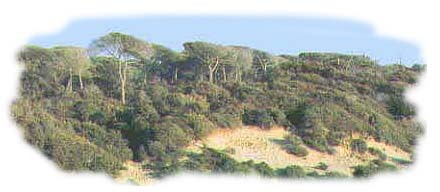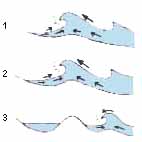
 The
Roman Coast was, many years ago, very different if compared to its present-day
appearance. The delta of the Tiber is the result of an evolution
that started at the beginning of the last ice-age, when the sea-level was
approximately 120 metres lower and the river flowed approximately 10 km
further out than today. As centuries passed, the sea-level continued
to rise, up until about 5,000 years ago, when the phenomenon stabilized
with the creation of a lagoon area. In the area of the mouth of the
lagoon, thanks to salt-water evaporation, there is an abundance of saltpans
that were utilized to their maximum capacity, during Ancient Roman times,
due to the wide use of salt in the preservation of foodstuffs.
The
Roman Coast was, many years ago, very different if compared to its present-day
appearance. The delta of the Tiber is the result of an evolution
that started at the beginning of the last ice-age, when the sea-level was
approximately 120 metres lower and the river flowed approximately 10 km
further out than today. As centuries passed, the sea-level continued
to rise, up until about 5,000 years ago, when the phenomenon stabilized
with the creation of a lagoon area. In the area of the mouth of the
lagoon, thanks to salt-water evaporation, there is an abundance of saltpans
that were utilized to their maximum capacity, during Ancient Roman times,
due to the wide use of salt in the preservation of foodstuffs.
During the Middle Ages, there was a phase of erosion,
in which a change in the course of the coastal area near the delta of the
Tiber occurred, caused, also, by the continual overflowing of the river.
In the 9th century, the delta assumed the characteristics that it
maintains today; that is, those of a sandy zone along the coast and a swampy
inland area, below sea level, invaded by small and larger pools.
At the beginning of the century, the inland area of the coast was reclaimed
and a network of canals was created. During the 'fifties,
the fight against the erosive phenomenon was initiated. This phenomenon
was caused mainly by the construction of dams and by the extraction of
sand and the materials in the basin of the Tiber, as well as by the progressive
disappearance of the stretch of vegetation (mediterranean maquis) that
grows on the dunes along the coast and that is nature's last defence stronghold
against erosion.
The mediterranean maquis that grows on the
dunes along the coast is a formidable natural defence against the erosion
caused by the sea. However, in order to fully understand this phenomenon,
it is important to understand, in depth, the coastal formation. Dunes
are sandy protuberances that accumulate along the coast, due to the action
of the wind. Dunes normally develop parallel to the coast and the
sediments taken into the sea by the Tiber are distributed by the sea itself
all along the coast. At this point, the sea's currents transport
these sediments toward the coast and, thus, layers of land emerge and are
subsequently covered by the downpour of sand brought by the wind.
With this sand, the coastal dunes "stabilize", allowing the birth of a
thick vegetation that blocks the advancing erosive phenomenon. As
the mediterranean maquis slowly moves away from the shore, it grows taller
(because the force of the wind weakens) and begins to develop into woods
and pine forests.
Today, the only evidence of such dunes can be
found in the area of Capocotta and Castel Porziano; unfortunately the vegetation
is constantly threatened by several different factors such as pollution
and the destructive behaviour of man himself.
 |
The action of the
sea in developing
of the dunes along
the coast.
|
 This Web Site has been realized and updated by the Lega Italiana Protezione
Uccelli
This Web Site has been realized and updated by the Lega Italiana Protezione
Uccelli
(Italian Society for the Protection of Birds)
- Roman Coastal Branch. For any information contact us:
 Lipu
Ostia
Lipu
Ostia
The information for realization of this page has been
drawn from the publication "Ambiente - i quaderni didattici sulla natura
del litorale" by Marco D'Amico.
Last update:
English translation by Christine Kinniburg
Copyright © 5/12/1997: Roberto Trezza

 The
Roman Coast was, many years ago, very different if compared to its present-day
appearance. The delta of the Tiber is the result of an evolution
that started at the beginning of the last ice-age, when the sea-level was
approximately 120 metres lower and the river flowed approximately 10 km
further out than today. As centuries passed, the sea-level continued
to rise, up until about 5,000 years ago, when the phenomenon stabilized
with the creation of a lagoon area. In the area of the mouth of the
lagoon, thanks to salt-water evaporation, there is an abundance of saltpans
that were utilized to their maximum capacity, during Ancient Roman times,
due to the wide use of salt in the preservation of foodstuffs.
The
Roman Coast was, many years ago, very different if compared to its present-day
appearance. The delta of the Tiber is the result of an evolution
that started at the beginning of the last ice-age, when the sea-level was
approximately 120 metres lower and the river flowed approximately 10 km
further out than today. As centuries passed, the sea-level continued
to rise, up until about 5,000 years ago, when the phenomenon stabilized
with the creation of a lagoon area. In the area of the mouth of the
lagoon, thanks to salt-water evaporation, there is an abundance of saltpans
that were utilized to their maximum capacity, during Ancient Roman times,
due to the wide use of salt in the preservation of foodstuffs.

![]() This Web Site has been realized and updated by the Lega Italiana Protezione
Uccelli
This Web Site has been realized and updated by the Lega Italiana Protezione
Uccelli